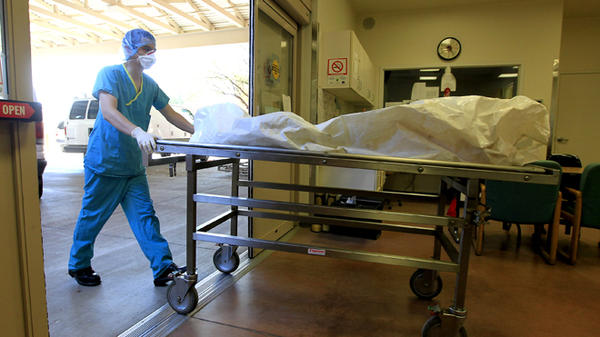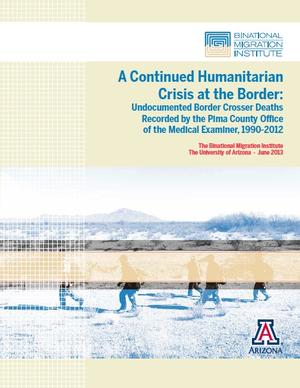 Moisés was a 33-year-old man from the Mexican state of Michoacán. He was on his way to Washington State to join his family and resume work after returning to Mexico for a brief visit. Moisés crossed the Mexico-U.S. boundary with a group of migrants near the town of Sonoyta, Sonora and entered the deserts of southern Arizona.
Moisés was a 33-year-old man from the Mexican state of Michoacán. He was on his way to Washington State to join his family and resume work after returning to Mexico for a brief visit. Moisés crossed the Mexico-U.S. boundary with a group of migrants near the town of Sonoyta, Sonora and entered the deserts of southern Arizona.
They crossed the third week of June 2008, a time when hundreds of Americans head south each year towards the sunny beaches of Puerto Peñasco, Sonora. Moisés didn’t make it. His remains were discovered about 30 kilometers north of Lukeville, Arizona, a couple hundred meters west of Arizona Highway 86—that stretch of road used by so many Arizonans as they head to their vacation spot in Mexico for a long weekend.
The discovery of Moisés’s remains was reported to the Tohono O'odham Police Department, who later turned his remains over to the Pima County Office of the Medical Examiner for investigation. The manner of death: probable hyperthermia. Like nearly half of the migrants who have perished while crossing the Arizona-Sonora border over the past two decades, Moisés died from exposure to the elements in the desert, where triple-digit heat is not uncommon in the summer.
Little is known about Moisés’s final moments in life, but it’s probable that a fellow traveler made the heart-wrenching decision to leave him behind once he could no longer keep up with the rest of the group. It is also likely that Moisés held on as long as he could, thinking of his loved ones whose faces were on the pictures he carried with him on his journey.
Did he clutch the rosary he carried with him from Michoacán and pray during his final moments? Or was his simply too exhausted and disoriented to remember it? What is known is that today, a woman in Washington is left without a husband and her children are without their father. On that June day in 2008, Moisés became one of the over 2,200 migrants to have died while attempting to cross through southern Arizona since fiscal year (FY) 1990.
Of the roughly 2,200 people who have died since FY 1990, 88% have died since FY 2002 alone. Migrant deaths in southern Arizona first began to increase around FY 2000 after border militarization efforts in traditional urban points of crossing during the mid-1990s began “funneling,” or redistributing, border crossers into the Sonoran desert.
The intent of the new boundary policing strategy was to push would-be unauthorized migrants toward hostile terrain, thus giving U.S. authorities a tactical advantage when attempting to apprehend those who remained undeterred.
Nearly 20 years after implementation of this strategy—as we document in a new report that our colleagues and we are releasing today through the Binational Migration Institute at the University of Arizona—the number of confirmed migrant deaths in southern Arizona have totaled near 150 or higher each year since FY 2002.
The Pima County Office of the Medical Examiner (PCOME) is the institution charged with investigating all unattended deaths in Pima County along with most of the other counties in southern Arizona. Today, the PCOME handles more cases of suspected UBCs than any other agency in the country. Between FY 1990 and 2012, the office investigated the remains of 2,238 undocumented border crossers (UBCs).
Key among our findings is that the number of UBC deaths in southern Arizona has remained near all-time highs despite 20-year lows in apprehension statistics for the Border Patrol’s Tucson Sector (which is responsible for policing most of the state’s boundary with Mexico). The multi-institutional report, coauthored by researchers from the Binational Migration Institute (BMI) and forensic scientists from the Pima County Office of the Medical Examiner, found that at least 171 migrants died while attempting to cross through southern Arizona in FY 2012. 
Although this number is the lowest count since 2008, when one considers this number relative to Border Patrol apprehensions in the same area (often used as a proxy for migration flow), the UBC death rate (142.5 deaths per 100,000 apprehensions) is the second-highest on record just behind last year’s at 146.8 deaths per 100,000 apprehensions in the Tucson Sector (see Figure 2 above). This rate, along with the recent increases in the number of cases of unidentified remains and of cases with a cause of death listed as “undetermined” due to advanced decomposition, suggests that people are being pushed farther and farther into remote desert regions when attempting to cross.
Moisés was typical of UBCs investigated by the PCOME: a Mexican male near the age of 30 from central or southern Mexico who died of exposure or probable exposure while attempting to cross the border.
Nevertheless, we find that the demographic characteristics of the deceased have changed over the past two decades. For instance, between 2000 and 2005, only about 9% of all UBCs identified by the PCOME were non-Mexican (nearly all Central Americans). By the 2006 to 2012 time period, that share nearly doubled to 17%.
There also appear to be fewer females crossing and dying today than during the 2000—2005 time period. Between 2000 and 2005, about 23% of UBC deaths were of females, compared to 16% during the current time period (2006—2012). These figures correspond with a decrease in U.S. Border Patrol apprehensions of females over the past several years.
It is likely that females migrated at higher rates between 2000 and 2005, a time period marked by a shift in seasonal migration among young males to more long-term settlement and family reunification. Prominent immigration scholars such as Douglas S. Massey and others working with Mexican Migration Project data have noted that this shift was an unintended consequence of increased border enforcement that ultimately contributed to the growth of the unauthorized population residing in the United States.
People like Moisés did not always die in high numbers along the U.S.-Mexico border. From 1990 to 1999, the average number of UBCs examined by the PCOME was 12. After new U.S. border policing measures went into effect in the late 1990s and early 2000s, the average leapt up more than tenfold. Between 2000 and 2005, the yearly toll averaged 134 individuals. Between 2006 and 2012, the grisly figure averaged 188.
This continues unabated, with concerning trends such as the increase of migrant deaths in Texas, suggesting that deaths along the entire border may be on the rise. In FY 2010 the Rio Grande Valley Sector reported just 29 migrant deaths. By FY 2012 that figure increased to 150 in the same area.
In addition, reports from places like Brooks County in South Texas indicate that the practices of investigating such deaths in small, impoverished, rural counties may fall short of best forensic practices meaning that families in search of missing loved ones may never get answers.
Although the number of Central Americans crossing and dying in southern Arizona has increased considerably over the past decade, this increase is likely much more pronounced in South Texas. In fact, last fiscal year, the number of non-Mexicans (again, likely overwhelmingly Central Americans) apprehended in the Rio Grande Valley Sector actually exceeded the number of Mexicans apprehended in the area.
This is far from the case in southern Arizona—Mexicans still make up over 85% of people apprehended in the Tucson Sector. Ultimately, it is very probable that a sizeable portion of the increase in migrant deaths in South Texas over the past two fiscal years have been the deaths of Central Americans, something that may also pose a challenge in successfully identifying the deceased and reuniting them with their loved ones.
In addition to adhering to the highest of standards in forensic scientific practice, the Pima County Office of the Medical Examiner has also facilitated knowledge about the crisis of migrant deaths through rigorous record keeping. Most notably, the office created coding criteria for undocumented border crosser (UBC) deaths, which has enabled studies such as the current report.
It is clear that a systematic, standardized way of tracking migrant deaths across the entire border is needed. This is easier said than done. But solutions cannot be planned carefully without valid and reliable data.
Although data from southern Arizona is organized and available for analysis, it saddens us that this data, concerning real human beings and their families, now includes scores of additional individuals each year—and has for over a decade.
We only hope that policy makers ensure that there are provisions in immigration reform that help end migrant fatalities. As history has shown, increased enforcement is not the answer—it will only lead to more death.
Daniel E. Martínez (mada0102@email.arizona.edu) recently successfully defended his dissertation in the School of Sociology at the University of Arizona and was hired as an Assistant Professor in the Department of Sociology at The George Washington University in Washington DC. His areas of research interest include immigration, criminology, and the sociology of race and ethnicity.
Robin Reineke (rreineke@email.arizona.edu) is a doctoral candidate in the School of Anthropology at the University of Arizona. Her dissertation, “Naming the Dead: Identification and Ambiguity along the U.S.-Mexico Border,” is about institutional and family efforts to identify the bodies of deceased migrants along the Arizona-Sonora portion of the U.S.-Mexico border. For the past seven years, she has worked at the Pima County Office of the Medical Examiner, where she co-founded the Missing Migrant Project. The project seeks to collect all missing persons reports relevant to the U.S.-Mexico border and to compare them to unidentified remains believed to be migrants. Her ethnographic research includes interviews and participant observation with forensic scientists and families of missing and deceased migrants in Mexico, Guatemala, and various parts of the U.S. She works with the Department of Justice’s Missing and Unidentified Persons System, the Argentine Forensic Team, the Binational Migration Institute, and various foreign consulates to develop systems to identify deceased migrants transnationally.

